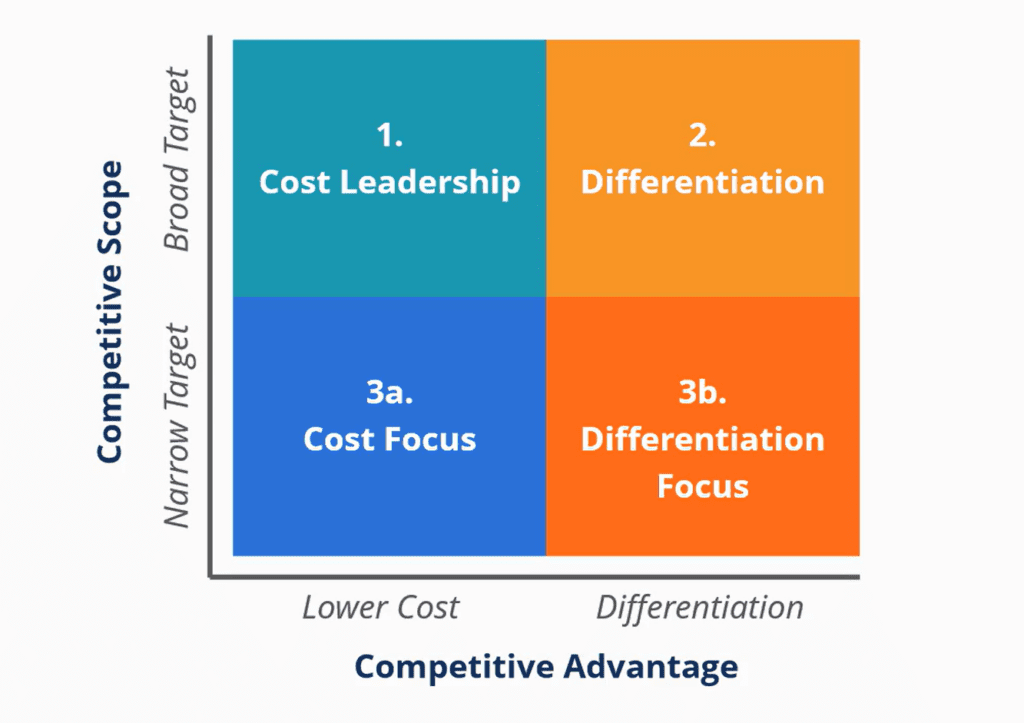
Competitive Advantage
The ability of a company to outperform its competitors
What is Competitive Advantage?
Competitive advantage refers to the ways that a company can produce goods or deliver services better than its competitors. It allows a company to achieve superior margins and generate value for the company and its shareholders.
A competitive advantage is something that cannot be easily replicated and is exclusive to a company or business. This value is created internally and is what sets the business apart from its competition.

Key Highlights
- A competitive advantage is what sets a company apart from its competitors, in the eyes of its consumers.
- These advantages allow a company to achieve and maintain superior margins, a better growth profile, or greater loyalty among current customers.
- A competitive advantage is often referred to as a “protective moat.”
- Strong and repeatable competitive advantages can create sustained success for a business and attract capital more readily and cheaply.
What are Some Examples of Competitive Advantage?
Competitive advantages come in many shapes and sizes. They include, but are not limited to, some of the following:
- Access to natural resources not available to competitors
- Highly skilled labor
- Strong brand awareness
- Access to new or proprietary technology
- Price leadership
Components of Competitive Advantage
For a competitive advantage to be established, it is important to know the following:
- Value proposition: A company must clearly identify the features or services that make it attractive to customers. It must offer real value in order to generate interest.
- Target market: A company must establish its target market to further engrain best practices that will maintain competitiveness.
- Competitors: A company must define competitors in the marketplace, and research the value they offer; this includes both traditional as well as non-traditional, emerging competition.
To build a competitive advantage, a company must identify its value proposition that will be sought after by the target market and cannot be replicated by competitors. One way firms can combine differentiation and low cost to build a defensible advantage is by pursuing a Blue Ocean strategy, which creates uncontested market space rather than competing with rivals in mature industries.
Building a Competitive Advantage
Michael Porter, the famous Harvard Business School professor, identified three strategies for establishing a competitive advantage: cost leadership, differentiation, and focus (which includes both cost focus and differentiation focus)[1].

1. Cost leadership
The goal of a cost leadership strategy is to become the lowest cost manufacturer or provider of a good or service. This is achieved by producing goods that are of standard quality for consumers, at a price that is lower and more competitive than other comparable product(s).
Firms employing this strategy will combine low profit margins per unit with large sales volumes to maximize profit. Companies will seek the best alternatives in manufacturing a good or offering a service and advertise this value proposition to make it impossible for competitors to replicate.
2. Differentiation
A differentiation strategy is one that involves developing unique goods or services that are significantly different from competitors. Companies that employ this strategy must consistently invest in R&D to maintain or improve the key product or service features.
By offering a unique product with a totally unique value proposition, businesses can often convince consumers to pay a higher price which results in higher margins.
3. Focus
A focus strategy uses an approach to identifying the needs of a niche market and then developing products to align to the specific need area. The focus strategy has two variants:
- Cost focus: Lowest-cost producer in a concentrated market segment
- Differentiation focus: Customized or specific value-add products in a narrow-targeted market segment

Competitive Advantage in the Marketplace
Three notable examples are:
- Walmart: Walmart excels in a cost leadership strategy. The company offers “Always Low Prices” through economies of scale and the best available prices of a good.
- Apple: Apple uses a differentiation strategy to appeal to its consumer base. It provides iconic designs, innovative technologies, and, therefore, highly sought-after products; this ensures that consumers are willing to pay a premium for Apple devices.
- Whole Foods Market: Whole Foods Market’s advantage relies on a differentiation focus strategy. The company is a leader in the premium grocery market and charges more premium prices because its products are unique. This is appealing to a niche market with higher disposable income.
What is the Importance of Competitive Advantage?
A competitive advantage is what sets a business apart from its competitors. It is essential in order for a business to succeed, whether it’s by ensuring higher margins, attracting more customers, or achieving greater brand loyalty among existing customers.
Higher margins, a better growth profile, and lower customer churn tend to also be very popular among both investors and creditors — making capital more readily available (and cheaper) for firms that are able to maintain a strong competitive advantage among their peers.
Video Explanation of Competitive Advantage
Watch this short video to quickly understand the main concepts covered in this guide, including the definition of competitive advantage and how companies create it using various business strategies.
Additional Resources
Analyzing Growth Drivers & Business Risks
Learn frameworks to assess the drivers of business success and how to use these findings to support more robust financial analysis.
